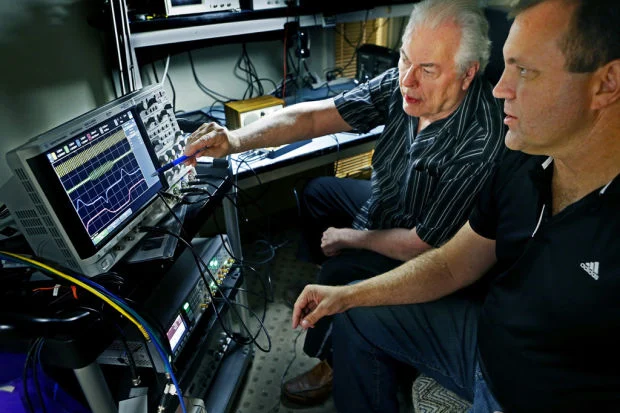Tucson tech: Local company rolls out bandwidth booster TM
ORIGINAL ARTICLE APPEARS on TUCSON.COM
 Everyone’s heard of AM and FM. Are you ready for TM?
Everyone’s heard of AM and FM. Are you ready for TM?
A Tucson-based company is working to commercialize a new communications technology – called Transpositional Modulation – that promises to multiply data-transmission rates for things like satellite and cellphone communications.
TM Technologies Inc., a spinoff of Tucson-based Medusa Scientific, said it has successfully demonstrated its “breakthrough” modulation technology after three years of intensive research and engineering.
The company says its technology can at least double data throughput by simply adding a signal in the same frequency band or by adapting it to existing communications technologies.
Medusa Scientific Chairman Dan Hodges said the technology could catch on quickly, as satellite and cell-phone carriers seek to slake their insatiable thirst for bandwidth.
“The idea behind it is, they’re limited in bandwidth,” Hodges said. “We saw that coming, so we said ‘how can you make this work where you can pack more data right up to the theoretical limit?’ ”
While enabling high-bandwidth technologies like streamed high-definition TV, boosting data throughput can also save money, Hodges said, noting that renting a single satellite data transponder can cost upward of $150,000 a month.
While TM technology is new, it comes with a pedigree.
The inventor, Medusa chief scientist Rick Gerdes, initially developed the concept in the 1980s, when he came up with the idea as a standard for digital television. That technology – which was tested at KMSB-TV Channel 11 in Tucson – showed promise, but the company withdrew its proposal when it became apparent the Federal Communications Commission favored other industry technologies, Gerdes said.
The idea was later incorporated into a software-based system that used part of the TV broadcast signal to rapidly download selected Web data to a computer via a TV tuner card.
Gerdes, who joined Medusa about three years ago, said the old DTV technology formed the foundation for the new TM technology, which is far more sophisticated.
He said the patents-pending TM system works by allowing two “carrier” signals to be carried on the same frequency, using time information to separate out the data.
In contrast, AM (amplitude modulation) carries information such as music audio by varying the amplitude, or strength, of a transmitted signal in relation to the information being sent. With FM (frequency modulation), the frequency of the carrier signal is varied.
Other researchers continue efforts to pack more information into the same bandwidth, using advanced data-compression schemes, for example.
“This is a whole new concept,” Gerdes said. “Even an engineer at FCC headquarters said that it was the first new form of modulation since FM,” said Gerdes, who started his electrical engineering career building his own ham-radio equipment at age 13.
While you won’t see “TM radios” anytime soon – the initial system works at the network level – the technology can greatly augment current communications systems.
TM is separately more efficient than either AM or FM, and it’s “mutually transparent” to AM or FM so it can be added or overlaid without disrupting accompanying signals, Gerdes said.
At the least, the technology allows at least double the throughput, but in some cases four or five times more, and in some extreme cases 30 times more data, he said.
Medusa is talking with several major telecom companies about TM technology, Hodges said, though he declined to identify them.
However, the company expects to complete a prototype satellite modem for testing by a prospective customer in August. A major wireless phone carrier is planning to test the TM system in the third week of August, as it looks to overhaul its wired back-haul networks, Hodges said.
And Medusa’s scientists are completing, for demonstration in early September, a capability to stream ultra-high-definition video for 4KTV via a single-signal transmission. Also known as 4K UHD, 4KTV boasts four times the resolution by pixel count as today’s top-end high-definition TV.
Ultimately, Hodges said, the company’s business model is to license the TM technology for free to device makers like set-top box manufacturers, and reap fees based on subscribers.
Though the 13-employee company is building its own circuit-board prototypes incorporating some 700 separate components, the TM technology will eventually be put on microchips for integration in devices, Hodges said. The company intends to stay focused on research and development rather than manufacturing.
TM Technologies represents an about-face for Medusa, a seven-year-old company that up to now has mainly worked on intelligence analytics projects for military and government agencies.
The company plans to sell its fleet of seven jet aircraft and a dozen helicopters to finance its new R&D programs, said Hodges, a former military pilot who still serves as a lieutenant colonel in the Arizona Air National Guard.
Other areas of research at Medusa, Hodges said, include development of ultra-sensitive electrical field sensors and hyperspectral imaging, which spans the infrared and ultraviolet frequencies.
At the center of those research efforts is Gerdes, who at 74 isn’t thinking about slowing down anytime soon.
“The ‘R’ word is not in my vocabulary,” Gerdes said.
Gerdes, now chief scientist at Medusa Scientific and TM Technologies, was one of the first employees of the former Burr-Brown Corp. in 1959.
He left to finish his electrical engineering degree at the University of Arizona in 1962. In 1964, he co-founded Optical Electronics Inc. in Tucson with his then-wife, Suzanne. Following the couple’s divorce in 1979, Suzanne Gerdes ran Optical Electronics and was leader of the local optics industry cluster group until her death from cancer in 2010.
“This is a whole new concept. Even an engineer at FCC headquarters said that it was the first new form of modulation since FM.”
Rick Gerdes, Medusa Scientific chief scientist


Leave a Reply
Want to join the discussion?Feel free to contribute!